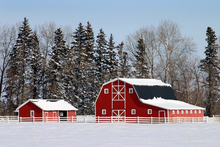Newsdate: Sat 28 December 2013 – 8:50 am
Location: GRAY SUMMIT, Missouri
Karen E. Davison, Ph.D., Equine Nutritionist and Sales Support Manager for Purina Animal Nutrition points out that winter means increased respiratory problems for some horses with its cold temperatures and inclement weather and asks horse owners to consider, "What may be floating around in your barn?"

Considering horse respiratory health in closed-up barns
Barns are often built for warmth and protection more than for air flow and ventilation, and measurements of the respirable organic particles in horse barns has shown potential respiratory dangers for horses.
"We want to keep our horses as comfortable as possible, which, to us, means keeping them warm and snug indoors when the wind is howling outside.
So, we blanket them, put them in warm stalls, close all the doors and windows, and feed them extra hay. They will be so warm and happy, won’t they? Well, they may be warm, but they may begin to have trouble breathing.
Barns are often built for warmth and protection more than for air flow and ventilation. Measurement of respirable organic particles or particulate matter in horse barns has shown potential danger for horses housed in barns.
Combine structure design with the potential for hay and bedding being stored in or near the barn, tractors and equipment running through from time to time, activities like sweeping aisles and cleaning stalls, then connect to an indoor arena, and the level of airborne organic dust can reach damaging levels.
When evaluating air quality, airborne particles in numbers greater than 2.4 mg/cubic meter (M3) of air have been shown to increase the incidence of airway disease.
In a study by Clements and Pirie (2007) that measured air quality in horse barns, most barns measured 40 - 60 mg/M3. The breathing zone of the horse during feeding time was often 30-40 times higher. Particles included dust, endotoxin, mold spores, ammonia and silica from arena dust. Hay has been measured to contain 19.3 mg/M3 and bedding, especially straw bedding, can be in that range or higher, making hay and bedding major contributors.
All these airborne particles can begin to wreak havoc on respiratory function in stabled horses.
Horses have an amazing respiratory system that is exceptionally equipped to function during exercise. Respiration rate (RR) varies dramatically from rest, 10-12 breaths per minute (bpm), to intense exercise, where it can increase to 150-180 bpm. Tidal volume (TV), the volume of air that is inhaled and exhaled with a normal breath, ranges from 4-7 liters per breath at rest. During strenuous exercise, TV increases to 10-12 liters.
Minute volume (MV) is the total volume of air inhaled and exhaled per minute (MV = TV X RR). Horses at rest have MV averaging 100 liters per minute, but during very hard work, MV averages an astounding 1,500 liters per minute. Even at rest, this is a tremendous amount of air flow into and out of the lungs. When the air being inhaled contains high numbers of respirable organic particles, the potential for irritation is high.
Add exercise on top of that, such as training in an indoor arena during the winter, and the increased respiration rate may cause deeper penetration of particulate matter.
In addition to air quality concerns, winter also brings frigid air temperatures. Research by Elfman, Pringle, Raine, and Riihimäki (2008) has shown that cold weather exercise can cause asthma-like airway disease in performance horses.
Repeated work in cold temperatures can lead to chronic airway inflammation. Non-infectious respiratory disease with airway inflammation in horses is a common clinical problem when horses are stabled. Some studies suggest that 25-80 percent of stabled horses suffer from Recurrent Airway Obstruction (RAO), commonly known as heaves, and Inflammatory Airway Disease (IAD).
Horses may suffer from chronic coughing, decreased performance, difficulty breathing and abnormal lung sounds. Signs do not become apparent until a large number of airways are affected and, therefore, many more horses may be affected than is realized.
Once this matter is in the airways, the body sees it as foreign material and mounts an inflammatory response. As the airways thicken, there is reduced oxygenation of blood, breathing becomes more labored and horses with RAO will begin to develop a “heave line” along the lower abdomen.
This heave line is the result of increased muscle development as horses work harder to force air out of the lungs with each exhale.
The most effective treatment for non-infectious respiratory disease is to prevent exposure to respirable irritants and to limit hard work during extreme cold temperatures. If horses cannot be kept outdoors, then the focus needs to be on reducing airborne particles from the barn. Improving ventilation in the barn and feeding low-dust feed can make a huge difference.
Feeding hay in feeders at ground level as opposed to hay racks above the grain is one step that may help, but hay should be thoroughly soaked in water and fed wet to adequately reduce dust and molds. In many cases, affected horses don’t show improvement until hay is totally replaced by feeding a complete feed with hay built in.
Purina Omolene #400 and Equine Senior horse feeds are low-dust feeds with quality fiber sources included to replace hay. Many horses with RAO or IAD cannot tolerate any hay, even wet hay, and do much better eating one of these products.
Keep in mind that horses eating hay in adjoining stalls can still cause problems for affected horses. Any time you notice coughing or labored breathing in your horse, make an appointment with your veterinarian for a thorough exam to determine the cause and the appropriate course of action to provide relief."
